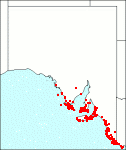Family: Ericaceae
Leucopogon parviflorus
Citation:
Lindley, Edwards' Bot. Reg. 18:t. 1560 (1833).
Synonymy: Styphelia parviflora Andrews, Bot. Rep. 4, t. 287 (1803); S. richei Labill., Nov. Holl. Pl, Sp. 1:44, t. 60 (1805); L. richei (Labill.)R. Br., Prod. Fl. Nov. Holl. 541 (1810).
Common name: Coastal bearded-heath.
Description:
Erect shrub or small tree, 120-500 cm high; stems redbrown; leaves erect to spreading, elliptic to oblanceolate, 11-29 mm long, 2.4-7.5 mm wide, apex obtuse, sometimes recurred, with a callus, base acute, margin entire, glabrous, lamina thin, convex to flat, discolorous, paler below, the upper surface with 3-5 parallel sunken veins, faintly striate below; petiole 0.
Flowers white, in dense clusters of 10-32 mm long spikes, terminal and in the upper axils, with 7-13 flowers plus up to 6 sterile bracts per spike; bracts 0.7-1.4 x 0.6-1 mm, usually acute, puberulent inside; bracteoles white, 1-1.35 x 0.8-1.1 mm wide, broadly acute; sepals white, 1.5-1.85 x 0.55-1 mm, acute; corolla tube broadly cylindrical, 1.45-1.7 mm long, upper 0.5-0.8 mm, puberulent inside; lobes 1.9-3.5 x 0.75-1 mm, acute, recurved, densely bearded inside; anthers 1.5-1.85 mm long, sterile tip bent or recurved, 0.3-0.5 mm long; ovary 0.75-0.9 x 0.65-0.75 mm, 4- or 5-celled; style 0.5-0.85 mm long, not exserted; nectary connate, readily breaking into scales, 0.4-0.55 mm high, the upper margin toothed or lobed.
fruit spherical, 4.5-5 x 3.25-5.05 mm, well exceeding the calyx, apex rounded.
Published illustration:
Rotherham et al. (1975) Plants of New South Wales and southern Queensland, fig. 19.
|
|
Distribution:
|
Common in coastal and near coastal eucalypt woodlands, open scrub and heathlands on sand dunes over limestone or granite.
S.Aust.: EP, YP, SL, KI, SE. W.Aust.; Qld; N.S.W.; Vic.; Tas. New Zealand.
|
Conservation status:
native
Flowering time: most of the year; fruit: Sept. — Feb.
|

SA Distribution Map based
on current data relating to
specimens held in the
State Herbarium of South Australia
|
Biology:
No text
Author:
Not yet available
|

